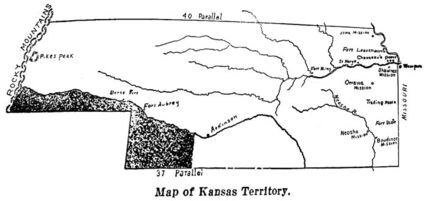Statehood out of wars and conflict
January 26, 2023
The story of Kansas as it became a state of the United States of America is much like a page out of today's conflicts, voting controversies and hardships.
Kansas had its start as property of France. In 1903, a treaty was made with President Thomas Jefferson to purchase the Louisiana Territory from France. This included Kansas lands. Kansas had been named after the Kansas River, that in turn had been named after the Native America Tribe of Kansas, meaning, "people of the wind." Jefferson decided he wanted to learn more about this new purchased territory so he arranged to have Lewis and Clark explore. They started up the Missouri River on May 10, 1804. In June they reached the Kansas River and made camp within the present limits of Kansas City, Kansas. The two explorers and their crew would go on through the Dakotas, the Rockies and on to reach the Pacific.
Two years later another expedition was sent out under the command of Lt. Zebulon Montgomery Pike, with the U.S. Army. His orders were to visit the Native American tribe of the Osage and then go on up to the Pawnees along the Republican River. He would end up counseling with 500 Pawnee warriors. It was then that he lowered a Spanish Flag that was there and raised the U.S. flag.
Pike was delighted in the sites along his routes and he said, "The prairie rising and falling in beauty swells as far as the sight can extend." Pike and party would cross the Arkansas River, the Kansas River, the Republican River, and back down to the Texas River. Part of his tour took him out to view the Rocky Mountains. It was then he viewed the blue cloud that would later turn into what he'd term, the Great White Mountain peak. It was later named Pike's Peak. Pike reported this territory would prove to be good settlement grounds.
Kansas, at one of it's earliest times was home to four Native American Tribes, the Osages, the Pawnees, the Kansas and the Padoucas. By 1825, the Shawnees arrived in Kansas. By the 1830s, Kansas became part of the Indian Territory as tribes were moved there including the Cherokees and other southern tribes. Forts were established with Leavenworth being the first, followed by Fort Scott and Fort Riley. By the early 1850s other tribes in the territory were Wyandottes, Delawares and the Ottawas.
On Jan. 24, 1854, there was a bill containing 38 sections. It contained the words that prohibited slavery, but left it to the respective territory to make a final decision on the matter of slavery or not. It took four months for this bill to pass and its direct result was the introduction of the the Kansas-Nebraska Act. This act defined the boundaries of the new territory, called the Kansas Territory. Then the conflicts began.
In the first election in 1854, of the newly formed Kansas Territory, it became an issue where the state legislature would meet as the territory government had no buildings of their own. The Pro-Slavery people wanted it in their area and the Free State people wanted it in their area. So in the first election a Pro-Slavery candidate faced off against a Free-State candidate, for a congress position. A large number of people from Missouri secretly crossed over into the voting places, to vote for the Pro-Slavery candidate. After the votes were counted, an investigation was called for but it ruled the the pro-slaves candidate had won the election legally. This matter inflamed the eastern United States and the free-state people in Kansas as they were determined Kansas would not become a slave state as neighboring Missouri was. The next election in 1855 brought armed men in from Missouri that stood guard at the voting places. Judges were appointed to also stand guard by the territory governor. Previous census was made establishing that there were 2,905 voters in the territory but at the election 6,318 votes were cast.
The judges had been forced to leave the voting places and so nothing would be done. Tempers rose and as the Kansas-Nebraska Act had stated the settlers would be allowed to regulate their institutions their own way. The Pro-Slavery people forced out the governor when the Pro-Slavery people passed a law there could be no anti-slavery person holding an office. Yet the anti-slavery settlers kept coming into the territory. The Missouri people did not allow any settler to come into Kansas Territory up the Missouri River, but the settlers came in through Iowa and Nebraska instead.
The Free-State politicians denounced the state legislature as fraudulent and the Free State organized the Topeka Government and a convention was held and the first constitution of Kansas was completed on November, 1855. A Pro-Slavery mob destroyed the poll books and the office of the Free State Newspaper, but the constitution passed anyway 1,731 to 46. The constitution proclaimed that Kansas would not allow slavery.
Killings, raids and tar and feathering occurred following the passing of that state constitution. Missouri forces came into the Kansas Territory and met up with state officers and The Wakarasa War as it was called, occurred. The governor called upon Colonel Sumner, of the U.S. Army to bring in troops and when they came the Missouri forces withdrew. The Pro-Slavery people arrested the governor and he was charged with treason, and they drove out other state government officials. The Pro-Slavery officials formed the Pro-Slavery Shawnee Mission Legislative.
On May 21, 1856, a large force of Missouri men burned down the Free State Hotel and destroyed the Herald of Freedom and Kansas Free State Newspapers. Stores in Lawrence were broken into and robbed. After that raid, the Free State forces attacked a Pro-Slavery headquarters within Missouri. Battles within the state legislature meetings continued. On July 4, 1856, Colonel Sumner came with five companies of soldiers and two pieces of artillery and was accompanied by a U.S. Marshal. Sumner and the marshal came into the halls of the state senate and ordered them to disperse and they did.
Voter fraud continued and on May 19, 1858, the Marais des Cygnes Massacre too place where men from Missouri came and lined up 11 Free State men and killed or wounded them.
On July 5, 1859, the delegates were not termed as Pro-Slavery or Free-State candidates but were termed to be either Republicans or Democrats which seemed to please everyone. There were 35 Republicans and 17 Democrats. The presented bill was "for freedom" and the bill of rights read, "there shall be no slavery in this state." The boundaries of Kansas were finally defined. On September 12, 1859, the state constitution was adopted with voters being 10,421 for and 4,772 against. The aim was hopefully statehood. A Kansas woman, Mrs. C.I.H Nichols, attended the daily sessions of the convention consulting for provisions that protected the rights of the wife, the mother and the lady citizens.
April 11th, 1860, the U.S. House passed the bill admitting Kansas into the union. The bill then went to the Senate where it was rejected. On Jan. 21, 1861, Jefferson Davis and other southern senators withdrew from the Senate. On that same day, William H. Steward called up the Senate to once again vote concerning the bill for admission of Kansas and it passed 36 to 16. The bill was then returned to the House and it passed out of regular order, 117 to 42. On Jan. 29, the act was signed by President James Buchannan and that day there after was known as Kansas Day. The morning of Jan. 30, 1861, found Kansas a Free State of the Union. The first United States Flag that included the star representing Kansas was raised over Independence Hall, on Feb. 22, 1861.
















Reader Comments(0)